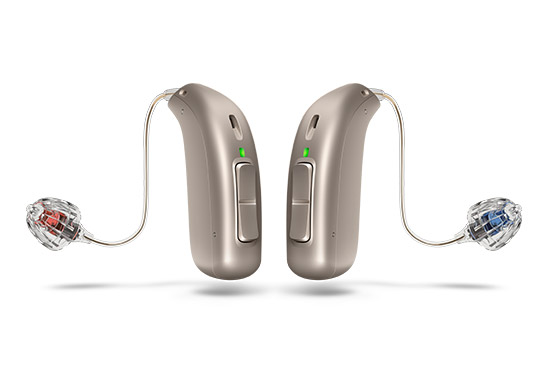All-new Oticon Zeal™ - The first, discreet hearing aid to do it all.
All-new Oticon Zeal™ - The first, discreet hearing aid to do it all.

Today we have more advanced options for treating hearing loss than ever before. At Hidden Hearing, our registered hearing care experts are trained to find the best treatment for your unique hearing needs.
In case you have a hearing loss, we offer the latest in hearing technology to help you hear better. But it all starts with a thorough examination of your hearing.

Types of treatments for hearing loss
Once one of hearing care experts has understood your hearing needs and has conducted an in-depth hearing evaluation, they'll discuss your treatment options with you. The most common treatment options are:
If hearing aids are recommended as part of your treatment plan, your hearing care expert can take you through the available solutions. There are many options to choose from which could suit your hearing and communication needs.

Just fill in your contact details below, and we'll contact you and find a time that suits you.
Hearing loss types and treatment
There are two main types of hearing loss: sensorineural and conductive. They affect different parts of the ear, so the recommended treatment differs for each type.
There are are other kinds of hearing loss that are unique in their symptoms and treatment options. You can read about standard treatment options for each by clicking on the hearing loss types and causes below.

Treating your hearing loss has a wide range of proven benefits:
Discover hearing aid styles for all degrees of hearing loss
Knowing your level of hearing loss is important as it'll help you understand what the best hearing aid for you might be. No matter your level of hearing loss, your hearing care expert will go through the available options to suit your specific needs.
Level of hearing loss
Invisible-in-the-canal |
Completely-in-the-canal |
In-the-canal |
Half/Full shell in-the-ear |
miniRITE (Receiver-in-the-ear) |
miniRITE R (Receiver-in-the-ear) |
Behind-the-ear Plus + Ultra Power |
|
| Mild to moderate hearing loss |
✔ |
✔ | ✔ |
✔ | ✔ | ✔ | ✔ |
| Severe hearing loss |
✗ | ✗ | ✗ | ✔ | ✔ | ✔ |
✔ |
| Profound hearing loss |
✗ | ✗ | ✗ | ✗ | ✗ | ✗ | ✔ |
Mild to moderate hearing loss
When finding a hearing aid to treat mild to moderate hearing loss, there are a wide range of hearing aid styles to choose from. Both in-the-ear and behind-the-ear hearing aid styles are suitable, and the features can be personalised based on your preferences.
Severe hearing loss
In the cases of severe hearing loss, behind-the-ear hearing aids are the most common hearing aid type. This is because they typically have the battery power and technology needed to effectively treat severe hearing loss. Full shell in-the-ear hearing aids may also be an option, depending on your hearing needs. But whichever option you choose, the features in the hearing aid can be catered to your personal needs.
Profound hearing loss
For those with profound hearing loss, if a powerful behind-the-ear hearing aid does not significantly improve the ability to hear in everyday life, then a hearing care expert may recommend surgical solutions such as cochlear implants or bone anchored hearing systems.
Read our 3-step guide to finding the best hearing aid for your needs


1. Beck D.L. (2012) British Academy of Audiology. Podium presentation
2. Clason, D. (2017, July 13). Can allergies affect your ears and cause hearing loss? Healthy Hearing. https://www.healthyhearing.com/report/51352-Can-allergies-cause-hearing-loss.
3. Clason, D. (2020, January 21). Dual sensory impairment: Hearing loss and vision loss. https://www.healthyhearing.com/report/52555-How-hearing-loss-is-different-than-losing-your-vision.
4. Clason, D. (2019, October 29). Sensorineural hearing loss (SNHL) causes. Healthy Hearing. https://www.healthyhearing.com/report/50276-Common-causes-of-sensorineural-hearing-loss.
5. G Livingston, Jonathan Huntley, Andrew Sommerlad, et al. Dementia prevention, intervention, and care: 2020 report of the Lancet Commission. The Lancet. July 30, 2020.
6. Frank R. Lin, M. D. (2011, February 1). Hearing Loss and Incident Dementia. Archives of Neurology. https://jamanetwork.com/journals/jamaneurology/fullarticle/802291.
7. Hearing Industries Association. (2019, March 27). MT10: MarkeTrak 10. Marketing Research, Inc.
8. Hearing Loss Association of America. (2018, May). Do you think you have hearing loss? https://www.hearingloss.org/wp-content/uploads/HLAA_DoYouThinkYouHave_Hearing-Loss.pdf?pdf=DoYouThink
9. Juul Jensen (2018). Closing a gap to normal hearing. Oticon White Paper.
10. Juul Jensen (2019). Oticon Opn S Clinical Evidence. Oticon White Paper.
11. Mroz, M. (2020, May 4). Hearing loss types - Learn about sensorineural, conductive and mixed. Healthy Hearing. https://www.healthyhearing.com/help/hearing-loss/types.
12. Oticon Opn S™ Hearing Aids l Oticon. https://www.oticon.com/breaking-the-rules.
3. Santurette, S., Ng, E. H. N., Juul Jensen, J., & Man K. L., B. (2020). Oticon More clinical evidence. Oticon Whitepaper.
14. U.S. Department of Health and Human Services. (2020, December 14). Sudden Deafness. National Institute of Deafness and Other Communication Disorders. https://www.nidcd.nih.gov/health/sudden-deafness.
15. U.S. Department of Health and Human Services. (2020, December 14). Noise-Induced Hearing Loss. National Institute of Deafness and Other Communication Disorders. https://www.nidcd.nih.gov/health/noise-induced-hearing-loss.
16. Victory, J. (2020, April 7). Bone-anchored hearing systems: What you need to know. Healthy Hearing. https://www.healthyhearing.com/help/hearing-aids/bone-anchored.
17. Victory, J. (2021, February). Sudden hearing loss in one ear. Healthy Hearing. https://www.healthyhearing.com/report/52462-Sudden-hearing-loss-getting-to-the-bottom-of-it
18. https://jamanetwork.com/journals/jamanetworkopen/fullarticle/2824287?resultClick=1
19. https://www.tandfonline.com/doi/full/10.1080/14992027.2019.1593523